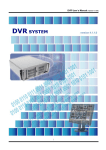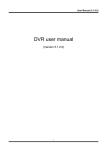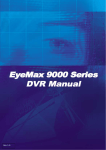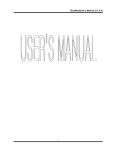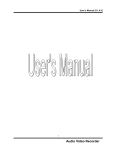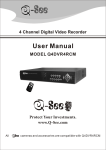Download Eyemax Magic Hybrid 16R User`s manual
Transcript
UNIX User’s Manual (4.1.1.0) 1 UNIX User’s Manual (4.1.1.0) TABLE OF CONTENTS Chapter 1. Hardware Installation ---------------------------------------------------- 5 1.1 Product Specification ------------------------------------------------------- 5 1.2 Product Components ------------------------------------------------------- 6 1.2.1 DVB-9030 -------------------------------------------------------- 6 1.2.2 -------------------------------------------------------------- 7 1.2.3 DVB – 9120 ----------------------------------------------------------- 8 1.2.4 DVB- 9480-------------------------------------------------------------9 1.2.5 DVB – 9420 ------------------------------------------------------------10 1.2.6 DVB – 9424 ------------------------------------------------------------ 11 1.3 Installation ---------------------------------------------------------------- 12 1.3.1DVB-9030 --------------------------------------------------------------12 1.3.2 ----------------------------------------------------------------14 1.3.3 -------------------------------------------------------------- 16 1.3.4 DVB - 9120 ---------------------------------------------------------- 18 1.3.5 DVB - 9480--------------------------------------------------------------20 1.3.6 DVB - 9420 ---------------------------------------------------------- 22 1.3.7 DVB – 9424 -------------------------------------------------------- 24 Chapter 2. Software Installation --------------------------------------------------- 26 2.1 Automatic Installation------------------------------------------------------- 27 2.1.1 Definition------------------------------------------------------------- 27 2.1.2 Installation Method Selection---------------------------------------------- 27 2.1.3 Installing Drivers------------------------------------------------------- 27 2.1.4 DVR File System Installation----------------------------------------------- 28 2.1.5 Completion & Retry----------------------------------------------------- 28 2.2 Manual Installation--------------------------------------------------------- 30 2.2.1 Definition ----------------------------------------------------------- 30 2.2.2 Installation Method Selection ---------------------------------------------- 30 2.2.3 Software Selection------------------------------------------------------ 30 2.3 Remote Client Installation---------------------------------------------------- 31 2.3.1 Using Magic Radar S/W ------------------------------------------------- 32 2.3.2 Using Web Browser -------------------------------------------------- 33 2.4 Uninstallation------------------------------------------------------------- 34 2.5 Program Execution -------------------------------------------------------- 35 Chapter 3. Main System Application (Control)----------------------------- ------------ 37 3.1 Startup Screen------------------------------------------------------------ 37 3.2 Login------------------------------------------------------------------- 37 3.3 Exit/Logout---------------------------------------------------------------38 3.4 Control Screen------------------------------------------------------------ 38 3.5 Setup------------------------------------------------------------------- 39 3.5.1 System -------------------------------------------------------------- 39 3.5.1.1 System Information---------------------------------------------------39 43.5.1.2 System Power Management--------------------------------------------40 3.5.1.3 Auto Switching Interval-------------------------------------------------40 3.5.1.4 E-map------------------------------------------------------------ 41 3.5.1.5 TV-out-------------------------------------------------------------42 3.5.1.6 On-screen Display----------------------------------------------------43 2 UNIX User’s Manual (4.1.1.0) 3.5.1.7 Text Inserter--------------------------------------------------------- 44 3.5.1.8 Hard Disk Usage------------------------------------------------------ 44 3.5.1.9 I-phone ------------------------------------------------------------ 44 3.5.1.10 Version Info.---------------------------------------------------------45 3.5.1.11 Maintenance Log------------------------------------------------------45 3.5.2 Device----------------------------------------------------------------- 45 3.5.2.1 Camera[Motion/Object Detection/People Counting]----------------------------- 46 3.5.2.2 Output Device -------------------------------------------------------- 55 3.5.2.3 Input Device---------------------------------------------------------- 56 3.5.2.4 Audio --------------------------------------------------------------- 57 3.5.2.5 Alert---------------------------------------------------------------- 58 3.5.3 Event------------------------------------------------------------------ 59 3.5.3.1 Input--------------------------------------------------------------- 59 3.5.3.2 Motion Detection------------------------------------------------------- 60 3.5.3.3 No Video Signal-------------------------------------------------------- 61 3.5.4 Schedule --------------------------------------------------------------- 61 3.5.4.1 Camera ------------------------------------------------------------ 61 3.5.4.2 Input---------------------------------------------------------------- 63 3.5.5 Network---------------------------------------------------------------- 64 3.5.5.1 DVR Server----------------------------------------------------------- 64 3.5.5.2 Web Server----------------------------------------------------------- 65 3.5.5.3 Central Station-------------------------------------------------------- 65 3.5.5.4 E-mail ------------------------------------------------------------- 66 3.5.5.5 Dial Alarm----------------------------------------------------------- 67 3.5.6 User----------------------------------------------------------------- 67 Chapter 4 View Log Application (Status)----------------------------------------------- 68 4.1 Screen Features------------------------------------------------------------ 68 4.1.1 Event Log-------------------------------------------------------------- 68 Chapter 5 Playback Application (Search)---------------------------------------------- 70 5.1 Search Features 1 ---------------------------------------------------------- 70 5.2 Search Features 2 ---------------------------------------------------------- 70 5.2.1 Playback-------------------------------------------------------------- 70 5.2.2 Event/Object/Text Search -------------------------------------------------- 71 5.2.3 Bookmark & Go To------------------------------------------------------ 75 5.2.4 Save ----------------------------------------------------------------- 76 5.2.5 Print ----------------------------------------------------------------- 78 5.2.6 Backup--------------------------------------------------------------- 79 Chapter 6 Remote Monitoring System (Client)------------------------------------------- 81 Appendix 1 POS DVR-------------------------------------------------------------- 83 1.1Hardware Installation------------------------------------------------------- 85 1.1.1 Parts -------------------------------------------------------------- 85 1.1.2 Installation ---------------------------------------------------------- 86 1.2 Software Installation ------------------------------------------------------87 1.2.1 Installation & Setup---------------------------------------------------- 87 Appendix 2 I-phone ------------------------------------------------------------90 2.1 Installation --------------------------------------------------------------91 2.2 Execution ---------------------------------------------------------------92 2.3 Audio Setup -------------------------------------------------------------92 Appendix 3 DVR Manager ------------------------------------------------------95 3.1 Installation --------------------------------------------------------------96 3.1.1 Start ---------------------------------------------------------------96 3 UNIX User’s Manual (4.1.1.0) 3.1.2 Selection of Installation Method --------------------------------------------96 3.1.3 On Installing -----------------------------------------------------------97 3.1.4 Finish ----------------------------------------------------------------97 3.2 Execution ----------------------------------------------------------------98 3.2.1 DVR -----------------------------------------------------------------98 3.2.1.1 Setup -------------------------------------------------------------98 3.2.1.2 Control ------------------------------------------------------------99 3.2.1.3 Search ------------------------------------------------------------100 3.2.2 MultiDVR -------------------------------------------------------------102 3.2.2.1 Setup -------------------------------------------------------------102 3.2.2.2 Control ------------------------------------------------------------103 3.2.3 C & S (Central Station) ---------------------------------------------------104 3.2.3.1 Setup -------------------------------------------------------------104 3.2.3.2 Event --------------------------------------------------------------105 3.2.3.3 E-map -------------------------------------------------------------106 4 UNIX User’s Manual (4.1.1.0) CHAPTER 1 HARDWARE INSTALLATION 1.1 Product Specification Models DVS-9030/ TS04 / DVS-9120 / DVB-9240 / DVB-9480 / DVB-9424 Displaying Speed 30fps(NTSC)/ 60 / 120 / 240 / 480 / 480 Recording Speed 30fps(NTSC)/60/ 120/ 240/ 120/ 240 Video Inputs 4/ 4/ 16 / 16 / 16 / 16 Audio Inputs 1/ 2/ 4/ 8/ 4/ 8 Sensor Inputs 4/ 4/ 16 / 16 / 16 / 16 Alarm Outputs 2/ 2/ 8/ 8/ 8/ Video Resolution 8 640 X 480 , 640 X 240 , 320 X 240 (NTSC) Compression Type Supported Signal Types MPEG-4 Supported Network Supported Backup Devices TCP/IP, PSTN Supported PTZ Protocols HDD, DVD/R, CD/RW, Network Driver, etc. C&B Tech-CND100200&SMART, Changzhou Minking-Minking, CTNCom-HD0670, Dong Yang Unitech-DSC230, DRAGON-DRAGON, Dynacolor-TPD7720, Geosan-GRX1000, GOLDENEYE-GOLDENEYE, InterM-VRX2201, KALATEL-KTD312, KJK-KJK, LG-LPTA100L, PELCO D&P, SAMSUNG-SCC641&SDZ160R&SPD1600&SPX1000&SPT1000, SONY-EVID3031, Vicon-Survey&2000, ZITEC-ZITECH, etc. Operating Systems Supported Languages Windows XP, Windows 2000, Linux English, Spanish, Japanese, French, Traditional Chinese, Simplified Chinese, Portuguese, Hebrew, Polish, German, Finnish, Greek, Hungarian, Korean, etc. 5 UNIX User’s Manual (4.1.1.0) CHAPTER 2 SOFTWARE INSTALLATION Steps: 1. Insert EyeMax S/W. 2. Double-click “EyeMax.English(4.1.1.0)”. 6 UNIX User’s Manual (4.1.1.0) 2.1 Automatic Installation 2.1.1 Definition: It is a method to install all the relevant softwares automatically. Select “Automatic Installation” at all times unless only “EyeMax Client” is to be installed. 2.1.2 Installation Method Selection 2.1.3 Installing Drivers 7 UNIX User’s Manual (4.1.1.0) 2.1.4 DVR File System Installation * Definition: Occupying disk capacity to record data * Steps: 1. Select drives from “Available Disk Drive Capacity” 2. Click “Add”. 3. Click “Initialization”. * Caution: 1. Be very careful not to add “C Drive”, for it is used for O/S and DVR softwares. 2. HDD has to be initialized to record data Selecting “Quick Initialization” will lead to the initialization of entire disk capacity added. Otherwise, put in desirable number to initialize. Note that the number can not exceed total capacity added. Initialization process will be performed automatically. Click “Close” upon completion. 8 UNIX User’s Manual (4.1.1.0) 2.1.5 Completion & Retry Retry the entire procedure if an error message is displayed. 9 UNIX User’s Manual (4.1.1.0) 2.2 Manual Installation 2.2.1 Definition: It is a method to install selected softwares manually. Select “Manual Installation” only in the case of “EyeMax Client” installation. 2.2.2 Installation Method Selection 2.2.3 Software Selection Note: The rest of the procedures are the same as “Automatic Installation”. 10 UNIX User’s Manual (4.1.1.0) 2.3 Remote Client Installation 2.3.1 Using EyeMax S/W Double-click “EyeMax(4.1.1.0)exe”. Select “Manual Installation”. Select “EyeMax DVR Client” only. 11 UNIX User’s Manual (4.1.1.0) 2.3.2 Using Web Browser 1. Type in the IP address of DVR server. 2. Log in first before downloading Remote Client Program. 12 UNIX User’s Manual (4.1.1.0) 3. Click the “Install Remote Client” button for downloading. 4. Downloading in progress 13 UNIX User’s Manual (4.1.1.0) 5. Click “Next” to proceed. 6. Select “Manual Installation. 14 UNIX User’s Manual (4.1.1.0) 7. Click “Next” to finish installation process. 2.4 Uninstallation 15 UNIX User’s Manual (4.1.1.0) 2.5 Program Execution Find the icons on the desktop to execute “EyeMax DVR” and “EyeMax DVR Client”. Or find “EyeMax DVR” under “All Programs”. 16 UNIX User’s Manual (4.1.1.0) CHAPTER 3 Main System Application (Control) 3.1 Startup Screen The above screen will appear as EyeMax DVR system starts. 3.2 Login The default values for User and Password are “admin” and “no password”. Click “OK” to execute EyeMax DVR system. To give “admin” a password and to create new users, certain configurations are required (Setup/User). Only “admin” and users with appropriate authorization have access to the Setup menu. Note: Vertual keypad is available wherever typing is required. 17 UNIX User’s Manual (4.1.1.0) 3.3 Exit/Logout To end EyeMax DVR system, select “Exit” and type in password. 3.4 Control Screen Model Setup Network Adjust PTZ Adjustment Camera Layout Panel PTZ Control Volume E-map I-phone Power Light Camera Selection Panel Manual Output Panel Control 18 Status Search UNIX User’s Manual (4.1.1.0) 3.5 Setup 3.5.1 System 3.5.1.1 System Information Create a DVR name and put in admin. info. They will be displayed on outgoing e-mails. 19 UNIX User’s Manual (4.1.1.0) 3.5.1.2 System Power Management * Reserved time: Time set to shut down or to reboot computer * Disable: selected when System Power Management is not to be used * Shutdown: selected when shutting down computer is required at the time set * Reboot: selected when rebooting computer is required at the time set * Exit & Turn off Computer: By checking the box, computer will be turned off automatically as a user exits from EyeMax DVR system. 3.5.1.3 Auto-switching Interval Auto-switching Interval is a function that allows green square around selected camera to move to the next one at the interval set. e.g.) Camera 1 > 10 sec. -> Camera 2 ->10 sec. -> Camera 3…. 3.5.1.4 E-map Click on the “E-map” button to design E-map. Click on “Open Map Image”to select an E-map image. 20 UNIX User’s Manual (4.1.1.0) The above is a designed E-map sample. Drag mouse to position Camera/Input/Output and design E-map. 21 UNIX User’s Manual (4.1.1.0) Click on the E-map button positioned next to the I-phone button to open E-map. White Camera: Not on Recording, Yellow Camera: On Recording, White Input/White Output: Not Activated, Yellow Input/Yellow Output: Activated 3.5.1.5 TV-OUT TV-OUT is a function that sends selected cameras to a call monitor (external analog monitor). Click on the “TV-OUT” button for setup. 22 UNIX User’s Manual (4.1.1.0) The Number of TV-out Supported T04 1 CS04 1 CD08 2 T08 2 CS08 1 LS16 2 T12 3 CS16 1 LD16 3 T16 4 CD16 2 * The models such as CD (240FPS/240FPS) and LS(480FPS/120FPS) support 2 TV-OUTs. LD16 (480FPS/240FPS) support 3 TV-OUTs and the rest of the models support 1. * Setup Options: 1. Same as Server Screen Mode ( For LS (480FPS/120FPS) only) - TV-OUT Monitor displays what’s on DVR server. Manual Channel Selection - Channels are selected manually. Once “Manual Channel Selection” is selected, channels can also be selected manually on Control screen by placing mouse on camera picture and clicking the right mouse. 2. Auto Channel Switching - Selected channels rotate to display at the switching interval set. * Switching Interval: The length of time to stay at one camera 3.5.1.6 On-screen Display * Show Camera Names and Status: By checking it, camera names and status will be displayed on camera pictures. * Show Motion Detection Blocks: By checking it, green motion detection blocks will be displayed on camera pictures when recording schedule is set as “M” (Setup/Schedule). * Show Object Detection Blocks: By checking it, blue object detection blocks will be displayed on camera pictures. 23 UNIX User’s Manual (4.1.1.0) Note : One right mouse click can be a very useful tool. Manual TV-out and OSD setup can be done. Additionally, instant recording can start by one click. 24 UNIX User’s Manual (4.1.1.0) 3.5.1.7 Text Inserter Text Inserter is a function that allows EyeMax DVR system to integrate with POS machines. Simply install “text_inserter_plugin_for_pos” on DVR Server, and transactions that occur will be displayed on selected camera pictures. Transaction recording and text search are possible as well. For more detailed installation and information, refer to Appendix 1. 3.5.1.8 Hard Disk Usage Hard Disk Usage is to select data storage method. If “Once” is selected, data will be stored up to the point where HDD reaches its maximum capacity. If “Recycle” is selected, data will be overwritten from the point HDD reaches its maximum capacity based on “First In First Out”. 3.5.1.9 I-Phone I-Phone is “Two-Way Audio Communication”. Check the box, go to Control Screen, and click on the I-Phone button for audio communication. For more detailed I-Phone setup, refer to Appendix 2. * Port No.: The port number for I-Phone use has to be set up. Normally the default value is good to use. * Timeout: It indicates the maximum length of connection trial. If there is no response within the value set, call will be cancelled. 25 UNIX User’s Manual (4.1.1.0) 3.5.1.10 Version Info. * Version 4.1.1.0: version name * Version 2005.4.14: built date 3.5.1.11 Maintenance Log It is used to record and view maintenance history. 3.5.2 Device Device sub-screen is divided into 5 different setup categories; Camera, Output, Input, Audio and Alert. All devices in each category can be set up on one same page. 26 UNIX User’s Manual (4.1.1.0) 3.5.2.1 Camera Cameras will be enabled by checking the boxes. Different resolutions and recording frame rates can be set up for different cameras. * Video Signal Type: Select either NTSC or PAL. * Auto Channel Scan: It automatically identifies all the active video channels. Make sure to always click and scan after S/W version change. * Default: It sets “Event Recording Frame” and “Recording Frame” as default values. [Camera] Double-click on “Camera”for more individual Camera setup. Select recording picture quality. * Pre-alarm (max. 10 sec.): Length of time to be recorded before event * Post-alarm (max. 60 sec.): Length of time to be recorded after event 27 UNIX User’s Manual (4.1.1.0) [Motion Detection] EyeMax DVR system is designed to have unlimited motion detection zones and to have different motion detection sensitivity levels. Zone Settings: 1. Select “Set”, drag mouse to set motion detection zones and click “OK”. 2. Select “Clear” to clear certain areas inside motion detection zones. 3. Click on “Clear All” to clear all the motion detection zones. [Object Detection] It is a function that marks any changes occurred from the original scene. 28 UNIX User’s Manual (4.1.1.0) Object Detection Blocks Click the right mouse and select “Clear Object Detection Blocks” to remove all the blocks. How to Set up: • Tick the “Object Detection” box and click on “Zone Settings”. • Drag the mouse to select object detection zone (same as “Motion Detection”). • Click on the “Set Frame” button to select original (default) image. • Go to “Detection Interval” and determine when to mark new object after its pause. • Go to “Setup/Schedule” and select “M” • Go to the “Control Screen” and find the red-squared “Object Detection” symbol. • One click on the “View Original Frame” button will display original image set. • Click it again to reactivate the “Set Frame” button. 29 UNIX User’s Manual (4.1.1.0) [People Counter] It is a function that counts people coming in and out of a certain place. How to Set up: 1. Click on the “People Count” button. 2. Tick the “Use People Count” box. 3. Set “Count Interval”. 4. Go to “Zone Settings and set “People Counting Zone”. 5. Go to Setup/Schedule and select “M”. 6. Go to the “Control Screen” and find the word, “Counting”. * Caution: “Object Detection” and “People Counter” can not be used simultaneously. 30 UNIX User’s Manual (4.1.1.0) [Mosaic] It is a function that veils restricted areas to keep regular users uninformed. How to Set up: • Tick the “Use Mosaic” box. • Click on “Mosaic Zone Settings”. • Set “Mosaic Zone”. • Go to the “Control Screen” and find veiled areas. Note 1. While using Mosaic, “Save” or “Print” can not be performed. 2. To see unveiled area, logging in as “Admin” or “Admin Mode” is required. [Data Retain] It is a function that retains data only for the period set. For example, if 10 days is set, MagicRadar will delete all previous data before 10 days regardless of the capacity remaining in HDD. 31 UNIX User’s Manual (4.1.1.0) [PTZ Camera Setup] When using a PTZ camera, check the box and select a model name. EyeMax DVR system supports nearly 40 different protocols. * Camera ID: Leave it as it is if only one PTZ camera is used. Otherwise, give each camera a different number. Select the port used for PTZ camera. * Bit per Second: It is 9600 for most of PTZ cameras. But a few can have different values. Refer to camera manual. * Apply All: The same settings will be applied to the rest of the cameras by clicking on “Apply All”. 32 UNIX User’s Manual (4.1.1.0) [Preset & Touring] Either click the right mouse on camera picture or click on the Preset (Touring) button for Preset (Touring) setup and use. [Preset] “Preset” is a function that enables a camera to move from one position to another automatically. 33 UNIX User’s Manual (4.1.1.0) * Steps to Set up Presets * 1. Move camera to a desired position using the PTZ Control on Control screen. 2. Click the right mouse. 3. Name the preset. 4. Repeat the above for setting up as many as 256 presets. 5. Click the right mouse to run preset and click the “Auto” button to stop it. 34 UNIX User’s Manual (4.1.1.0) [Touring] “Touring” is a function that enables a group of selected presets to work repeatedly. * Steps to Set up a Tour * 1. Click the right mouse. 2. Name the tour. 3. Click on “Add”. 4. Select a preset. 5. Click “OK”. 6. Repeat the above to have more than 1 preset in the tour. 7. Click the right mouse to run the tour. * Dwell: The length of time that camera will pause before moving to the next preset. * Speed: Moving speed for selected preset. 35 UNIX User’s Manual (4.1.1.0) 36 UNIX User’s Manual (4.1.1.0) Advanced PTZ setup can be done by one right mouse click. Make sure that the PTZ camera to set up supports advanced PTZ control functions first. 37 UNIX User’s Manual (4.1.1.0) 3.5.2.2 Output Device EyeMax DVR system can be equipped with as many as 8 output devices. Simply check the boxes for use. In addition, outputs can be manually activated from Control screen (Manual Alarm). Double-click on “Output” for individual output setup. * * * * Name: Output device name. Length of Activation: The length of output activation (1-60 sec.). Length of Standby: The length of output deactivation until reactivation (0-60 sec.). Apply All: The same settings will be applied to the rest of the output devices. 38 UNIX User’s Manual (4.1.1.0) 3.5.2.3 Input Device EyeMax DVR system can be equipped with as many as 16 input devices. Simply check the boxes for use. Each and every input can be tuned independently. * Signal Types: NO: (+) & (-) detached normally NC: (+) & (-) attached normally 39 UNIX User’s Manual (4.1.1.0) 3.5.2.4 Audio EyeMax DVR system is equipped with as many as 8 audio channels. Simply connect cameras to audio channels for use, and audio recording will be completed as chosen. (e.g.) The above selections indicate that Audio2 will record Camera3, Audio3 will record Camera5, etc. Input Gain (1-15): It is audio level control similar to volume control. 40 UNIX User’s Manual (4.1.1.0) 3.5.2.5 Alert EyeMax DVR system is equipped with 1 alert device. Alert is the beep inside the system that sounds in the case of event. Check the box for use and select an alert mode. Length of Activation: The length of alert activation (1-60 sec.). 41 UNIX User’s Manual (4.1.1.0) 3.5.3 Event “Event” consists of 3 different groups; “Input”, “Motion Detection” and “No Video Signal”. On this menu, devices can be set to respond to different events. 3.5.3.1 Input * Length of Full Screen Display: The time length for full screen display in the case of input device activation. * Full Screen Display Channels: Camera channels to be full-screen displayed. * Link to Recording: One Input device can have as many as 16 recording cameras on activation. The below example shows that Camera1 will record in the case of Input1 activation. * Link to Output: One Input device can have as many as 8 activating output devices on activation. The above example shows that Output1 will be activated in the case of Input1 activation. * Link to Alert: Input device can also be linked to alert. 42 UNIX User’s Manual (4.1.1.0) 3.5.3.2 Motion Detection The same identical concepts and methods as “Input” are applied to “Motion Detection”. 43 UNIX User’s Manual (4.1.1.0) 3.5.3.3 No Video Signal The same identical concepts and methods as “Input” are applied to “No Video Signal”. The above example shows that Camera2 will take over and record if there is a signal cut in Camera1. 3.5.4 Schedule “Schedule” is a place where the different activities of different devices are determined. 3.5.4.1 Camera Each camera can have different recording options; scheduled recording by time & day and selective recording. * R: Recording at all times * M: Recording only on motion detection * S: Recording only on sensor detection * H: Recording at all times and higher frame recording on sensor/motion detection 44 UNIX User’s Manual (4.1.1.0) The holiday recording schedule set at the bottom of the “Schedule” table will be applied to selected dates. [Manual (Instant) Recording] It is a function that enables users to react on an emergency situation properly by making MagicRadar start recording immediately. Start “Manual Recording” by selecting “Recording On”. Stop “Manual Recording” by selecting “Recording Off”. Note : 1. The purple icon indicates that it is on “Manual Recording”. 2. Only ‘Admin’ can use “Manual recording”. 45 UNIX User’s Manual (4.1.1.0) 3.5.4.2 Input 3.5.4.3 Input 46 UNIX User’s Manual (4.1.1.0) 3.5.5 Network 3.5.5.1 DVR Server * Supported Network: 1. TCP/IP - Connecting to DVR Server from Client using Lan or DSL 2. PSTN Connecting to DVR Server from Client using PSTN or ISDN modem 3. None Not allowed to connect to DVR Server remotely * Port No.: The default port number is 9091. * Timeout: The time length of trials to connect to DVR Server from Client * Maximum Users: The maximum number of users that can be logged in remotely. * Details: It shows all the port numbers that are available to use. 47 UNIX User’s Manual (4.1.1.0) * Transmitted Video Quality: Video quality to be transmitted to Client. As a reminder, the higher video quality gets, the slower network transmission speed becomes. Therefore, it is often recommended to select low video quality when using “Narrowband”. * Bandwidth: Make sure to select the right bandwidth to have the right network performance. Router in Use: If there is a router in use, follow the steps below: 1.Check the box above. 2.Type in router’s IP address. 3.Go to router setup. 4. Register DVR’s IP address. 5. Put in all the port numbers under “Details”. 3.5.5.2 Web Server * Port No.: Fixed HTTP Port No. * Web Login Required: If the box is checked, login is required when connecting to DVR server using web browser. If the box is NOT checked, automatic login as “anonymous” will be done. 3.5.5.3 Central Station “ Central Station” is a function that enables Client with static IP to manage multi DVR sites. Check the box and click on “Properties” for setup. * Note: “DVR Manager” must be installed on Central Station Server (Client). For more details, refer to Appendix 3. Type in the IP address of Central Station Server (Client with Static IP) and click on “Reported Events” for more setup. 48 UNIX User’s Manual (4.1.1.0) Choose events to report to Central Station server and set reporting time period. 3.5.5.4 E-mail E-mail is a function that enables EyeMax DVR system to send out e-mails when selected events occur. Check the box and click on “Properties” for setup. Note : Some e-mail servesr may require authentication for ID and PW. Make sure to put in the right IP address of SMTP server. Then, click on “Reported Events” for more setup. The “Reported Events” menu is the same as Central Station. 49 UNIX User’s Manual (4.1.1.0) 3.5.5.5 Dial Alarm “Dial Alarm” is a function that enables EyeMax DVR system to call out on selected events. Check the box and click on “Properties” for setup. Modem card must be installed inside EyeMax DVR system to make this function work. Type in phone (mobile) number to report. Click on “Reported Events” (same setup as Central Station) for more setup. 3.5.6 User Users can be added, deleted or modified with different authorized access and control levels. There are no limits in the number of users created. 50 UNIX User’s Manual (4.1.1.0) * Authorized Access: Checked functions will be allowed to access remotely. * Accessible Channels: Checked channels will be allow to view remotely. * Control Level: The lowest number will be allowed to have the first priority to set up, control, etc remotely. * Admin Mode: A user who can go into the setup and program (given the same authorization as “Admin”). Only ONE user with “Admin Mode” can log in remotely. * Network: If checked, remote access authorization will be given. * Multi-access: If checked, multi-users with the same user name can log in remotely at the same time. CHAPTER 4 View Log Application (Status) 4.1 Status Screen 51 UNIX User’s Manual (4.1.1.0) 4.1 Screen Features Recording Camera: It shows recording status. Sensor Detection: It shows sensor detection status. Motion Detection: It shows motion detection status. Alarm: It shows alarm activation status. HDD Capacity: It shows HDD capacity used for recording. Event: It shows events occurred. Event Log: It shows all the previous events occurred by date. 4.1.1 Event Log * Date: All dates with events will be marked in bold numbers. * List: All events for a certain selected date will be shown. * Delete All: If clicked, all the previous records will be deleted. * Delete: If clicked, only the events for a certain selected date will be deleted. * Refresh: If clicked, events will be updated. * Network Client Log : Remote login records will be also kept on DVR server. 52 UNIX User’s Manual (4.1.1.0) CHAPTER 5 Playback Application (Search) 5.1 Search Screen 5.1 Search Features 1 Calendar: All dates with recorded data will be marked in bold numbers. Blur/Sharp/Normal: Buttons to adjust sharpness of image Zoom: Buttons to zoom in/out Brightness: buttons to adjust brightness Contrast: buttons to adjust contrast Default: Default for Zoom/Brightness/Contrast 5.2 Search Features 2 5.2.1 Playback 53 UNIX User’s Manual (4.1.1.0) For playback, simply select date, screen mode (1, 4, 9, 16, etc.), time by one click on the time bar and click the play button. What different colors mean on the time bar: 1. Blue: Recorded data by sensor & motion detection 2. Purple: Recorded data by 24-hour-recording 3. White: No recorded data in all cameras 4. Gray: No recorded data for some cameras 5. Green: Blue + audio 6. Light Green: Purple + audio 7. Orange: Recorded text data (POS) Stop Play Backward * 2 Play Play * 2 Play Backward Event/Object/textSearch Move to the First Data Move to the Last Data Move1 Frame Backward Move 1 Frame Forward 5.2.2 Event/Object/Text Search/PEOPLE COUNT [Event Search] Click the Event/Object Search button and select “Event”. 54 UNIX User’s Manual (4.1.1.0) Select channels for Event Search. Select one event from the event list and click “OK”, and the selected event will be displayed. Click Refresh” to update the list. [Object Search] Object Search is only to search certain selected objects for a certain period of time. Scan: Set the time period for object search Motion Detection Zone: Select “Set” and mark areas for object search by dragging mouse. “Clear” is used to erase certain areas inside motion detection zones. Sensitivity: Set motion detection sensitivity level. Clear All: Click on it to clear all the motion detection zones set. 55 UNIX User’s Manual (4.1.1.0) [Text Search ] It is to search POS text data with image according to selected time period and item. Put in an item (Reference), select time period and click on “Search”, and a list with transactions will be displayed. 56 UNIX User’s Manual (4.1.1.0) [People Count Search] It is to search people count statistics according to selected time period & camera. Select date, camera & time, and statistics will be shown as below. Statistics can also be saved as text file. 57 UNIX User’s Manual (4.1.1.0) 5.2.3 Monitoring & Searching It is a feature that enables user to view live video while searching recorded data. Click the right mouse and select “Monitoring On” to view live video. Click the right mouse again and select “Monitoring Off” to go back to “Search Mode”. 58 UNIX User’s Manual (4.1.1.0) 5.2.4 Bookmark & Go To Bookmark (Favorites): Added data from “ Object Search” are stored here. Go To: Select desired time to search and click “OK”. 59 UNIX User’s Manual (4.1.1.0) 5.2.5 Save AVI: For saving motion pictures and audio BMP: For saving images. Watermarked images can be saved. JPEG: For saving regular still images. Quality is not as good as BMP but less HDD is used. Save in JPEG with Time Period: For scheduled save in JPEG [Save in AVI Format] Click “Start” to start saving and “Stop” to stop saving. Mute: Saving video only (no audio) High Speed: Saving in high speed 60 UNIX User’s Manual (4.1.1.0) [Save in BMP Format] Click “Start”and select “BMP” as you save images. Saved images can be checked using “Watermark Proofer”. [Watermark Proofer] Execute “Watermark Proofer” and check if certain saved images are forged or not. 61 UNIX User’s Manual (4.1.1.0) [Save in JPEG Format] [Save in JPEG with Time Period] Click “Start” and select “JPEG” as you save images. Select time period and select channels to be saved in JPEG. 5.2.6 Print Click the “Print” button and follow the same printing procedure as you would normally print out documents. 62 UNIX User’s Manual (4.1.1.0) 5.2.7 Backup The recorded data can be copied from the hard disk to external storage devices, such as CD-R, DVD. Back up recorded data using various backup devices. 5.2.7.1 DFS Back up 63 UNIX User’s Manual (4.1.1.0) Select Time Period : Specify time period for backup. The minimum period for backup is 1 minute. If password is set, viewing backup data will be possible only when it is typed in. Backup Folder : Click the “Browse” button, select a drive to back up and enter a desired folder name. 64 UNIX User’s Manual (4.1.1.0) 65 UNIX User’s Manual (4.1.1.0) 5.2.7.2 EXE Back up Any recorded data can be saved as “.exe” file. No viewer program is required to see saved data. Note : 1. file size limited up to 1 GB. 2. 1 channel backup only. 66 UNIX User’s Manual (4.1.1.0) 1. 2. 3. 4. 5. 6. Select “EXE File”. Specify time period, password, drive, etc. Select ONE channel to back up. Specify file size up to ONE GB. If it is larger than 1GB, multiple exe files will be created. Tick the “Once Make EXE File” box to create only one file with the file size specified. Double-click the exe file created to see data. 67 UNIX User’s Manual (4.1.1.0) 5.2.7.3 Run CD Burner ( For Non Windows XP Users) 1. Install bundle CD and install INCD. 3.After installing INCD, run “InCDL.exe” which is the INCD Launch Program. 4. Insert a blank RW CD and then start formatting it (If it is a brand-new one, click “Format” instead of “Quick Format”). 68 UNIX User’s Manual (4.1.1.0) 69 UNIX User’s Manual (4.1.1.0) 5. Leave the MagicRadar Program and insert the blank RW CD which has been formatted. 6. Select “Backup” and click “Next” to start. 7. Select time period & password and click “Browse” to create a folder. 70 UNIX User’s Manual (4.1.1.0) 71 UNIX User’s Manual (4.1.1.0) 5.2.7.4 Run CD Burner ( For WindowsXP Users Only) Windows XP users can back up data directly in a CD without exiting the MagicRadar Program. 1. Tick the “Save in CD data of backup” box and click “Next”. 72 UNIX User’s Manual (4.1.1.0) 5. 6. 7. 8. Select Time Period : Specify time period and password. Select CD-RW drive. Create folder name if it should be used and click “Next”. CD information will be shown as below. 73 UNIX User’s Manual (4.1.1.0) 3. Select 1 channel to back up. 4. Identify the maximum file size indicated. An attempt to back up more than the size indicated will result in a failure. 74 UNIX User’s Manual (4.1.1.0) 2. After completing back up, find the files created in the CD. 75 UNIX User’s Manual (4.1.1.0) 5.2.7.5 Playback 1. 2. Click the “Start” button and run the “DVR’s Playback Program”. Select a folder (subfolder) to see saved data. 76 UNIX User’s Manual (4.1.1.0) CHAPTER 6 Remote Monitoring System (Client) 6.1 Program Execution Double-click on the “EyeMax DVR Client” icon on the desktop to execute Remote Monitoring System (Client). Click “Add” to register DVR servers. Note: Make sure to put the same Port No. as DVR server. 77 UNIX User’s Manual (4.1.1.0) There can be more than one DVR server registered. Select one from “Servers”, click on “Login” and type in password to log in. * Edit: Login info. changes can be made here. * Delete: Registered servers can be deleted with one click. Full Screen Display on Event: If checked, full screen will be displayed on events. 78 UNIX User’s Manual (4.1.1.0) 6.2 Remote Save and Backup The instant AVI file save of real time video can be done remotely. 1. Click the right mouse to start saving. 2. Click the right mouse to stop saving. Remote Backup can also be done. The same procedure is used as “DFS Backup”. 79 UNIX User’s Manual (4.1.1.0) 6.3 Real Time Audio Click the right mouse and select “Enable Audio” to hear real time audio. Note: Changing “Setup” remotely can be done if remote user is “Admin” or “Admin Mode”. 80 UNIX User’s Manual (4.1.1.0) Appendix 1 POS DVR TABLE OF CONTENTS 1.1 Hardware Installation 1.1.1 Parts 1.1.2 Installation 1.2 Software Installation 1.2.1 Installation & Setup 81 UNIX User’s Manual (4.1.1.0) 1.1 Hardware Installation 1.1.1. Parts 5 1 + 2 4 3 6 82 UNIX User’s Manual (4.1.1.0) Part Names 7 8 9 83 1.RS232 Serial Cables (Cross & Direct) 2. RS232 Serial Cable 3. RS232 Serial Cable 4. RS232 Serial Converter (9 pins into 25 pins) 5. Gender Changer 6. #1 + #4 + #5 7. DVR 8. POS Printer 9. Point of Sales (POS) UNIX User’s Manual (4.1.1.0) 1.1.2 Installation Part # 2 goes into the COM Port 1 of Part # 7. Part # 1 goes into the serial port of Part # 8. Part # 3 goes into the serial port of Part # 9. 84 UNIX User’s Manual (4.1.1.0) 1.2 Software Installation 1.2.1 Installation & Setup Install “text_inserter_plugin_for_pos” on DVR Server. Click “Next” to start. 85 UNIX User’s Manual (4.1.1.0) Select “Typical Installation” for automatic installation. Select camera channels and click the com port buttons for serial port configuration. Make sure to select “COM1” if POS printer is connected to com port 1. The Baud rate value is normally 9600. 86 UNIX User’s Manual (4.1.1.0) Click “Finish” to complete. Leave everything else. Select words to be highlighted and words to be omitted. Go to “Text Inserter” in the DVR setup and choose different fonts and different display corners. 87 UNIX User’s Manual (4.1.1.0) Appendix 2 I-phone TABLE OF CONTENTS 2.1 Installation 2.2 Execution 2.3 Audio Setup 88 UNIX User’s Manual (4.1.1.0) 2.1 Installation Any system used for “Two-way Communication” must have static IP and “iphone(1.0.1.0).exe” must be installed. For I-phone installation, double-click on “iphone(1.0.1.0).exe”. Click “Next” to start installation process and select “Automatic Installation”. 89 UNIX User’s Manual (4.1.1.0) Click “Finish” to complete the process. 2.2 Execution Go to “Start”, “All Programs”, “I-phone” and select it for execution. find Find the I-phone icon at the right bottom and click it for the next step. 90 UNIX User’s Manual (4.1.1.0) Select “Call” for Two-Way Communication”, type in IP address and click “Connect”. Property: The default port number is 8015 and the default timeout value is 5 seconds. Leave them as they are unless other values must be used. 2.3 Audio Setup Go to “Control Panel”, ”Sounds, Speech and Audio Devices” and “Sounds and Audio Devices”. Then, go to “Audio”, “Sound playback” and click “Volume”. 91 UNIX User’s Manual (4.1.1.0) Recording Control should be set up this way. 92




























































































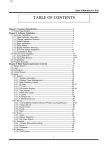
![[Proxyview]User`s Manual (5.1.4.0)](http://vs1.manualzilla.com/store/data/005658349_1-e7f841297d622d23913e7f3fcabf599d-150x150.png)
